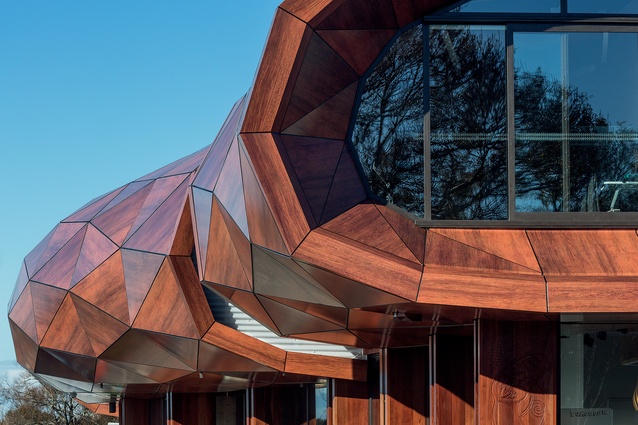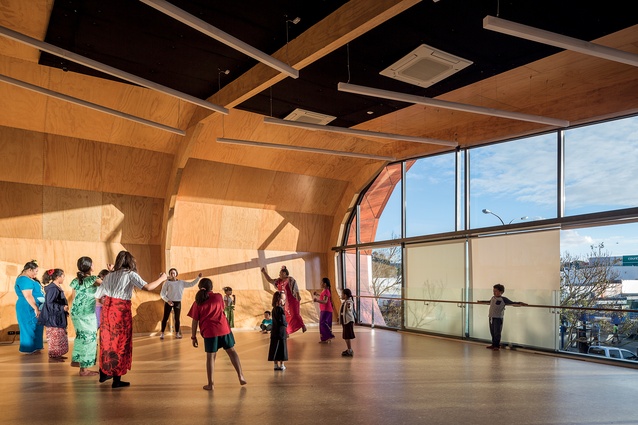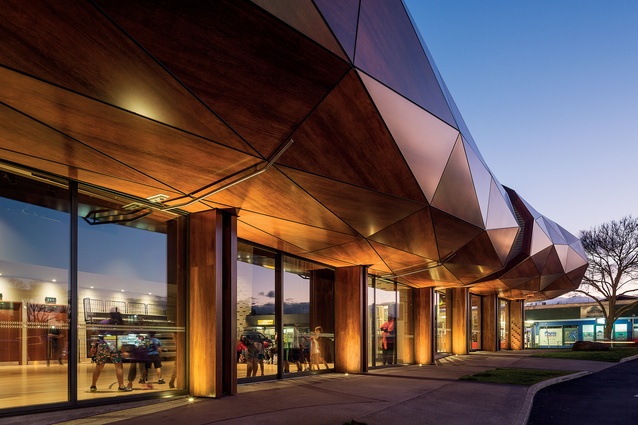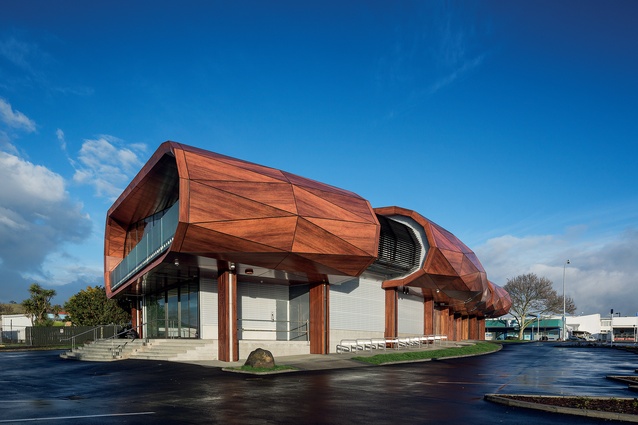Reasserting heritage: Te Oro
With its roots in Pacific culture, Archimedia’s new community and arts centre in Auckland’s Glen Innes has been likened to “a giant musical instrument”, “a grand tree hut” and “a vessel that nurtures young dreams”.
Te Oro, a new community and arts centre for young people, has been a long time in coming to Glen Innes. GI, as we know it in Auckland, is one of those vast areas of paddock transformed by the first Labour government’s massive state housing programme of the 1940s. But the tragedy of that programme was that the town centres envisaged for them (and designed by people such as emigré modernist Ernst Plischke) were never built.
Where Plischke and co in the Department of Housing Construction imagined transport interchanges, town squares and community centres that would be the hearts of new towns, the result, generally, was a row of shops, a hall (if you were lucky) and more and more suburban sprawl. The development of these acres of housing and culs-de-sac also altered the natural environment: piping creeks, asphalting grasslands and masking any sense of local indigenous history in the landscape.
Archimedia’s new building aims not just to provide the venue for activities but to reassert some of that heritage and acknowledge the concerns and values of the largely Māori and Polynesian population. The building is unmissable in the main street and a striking change from the wooden boxes and low prefab-like community rooms and so on that dot the precinct. One local told me it’s a big kava bowl and I do have a very free-form one I was given in Niue, seemingly hewn from half a tree, which bears a bit of a resemblance.
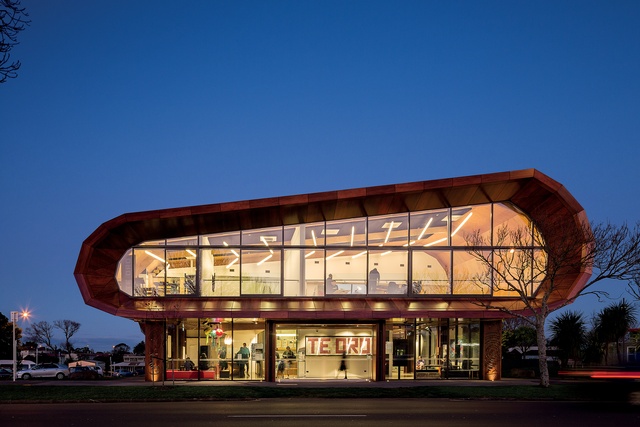
Te Oro is not a kava bowl, of course, nor a Pacific Island drum, as someone else suggested, but it is encouraging that it is seen in terms of Pacific metaphors and not as something alien. The name Te Oro, gifted by Ngāti Paoa and endorsed by other Tāmaki Makaurau iwi, refers to sound in a chamber or a reverberation and is something historically associated with the local maunga Maungarei. It fits the activities and spaces that occupy the building and also poetically describes the building, which can be seen as a flattened tube, a giant instrument.
Te Oro is most like a pavilion in form, with the possibility of internal spaces opening out on any sides at ground level. The many technical spaces on the upper floor, such as recording studios, allow the rare opportunity for a solidity that permits the building to take on the sculptural quality upon which the local architecture commentators have remarked.
Slices in the carapace of the building mark circulation spaces and the ends open up, with studios and balconies that allow an engagement with the street at one end and a view out over the landscape at the other. In plan, the building slews sideways, inflecting itself away from the marae next door in a gesture of respect and deference. And, at what, normally, we would call the rear, there are a set of steps and a stage-like terrace that address the landscape and look out over a traditional path down to the Tāmaki River. This also creates a waiting space for those about to go on to the marae. This building is assisting in shaping up a welcome redevelopment of the precinct.
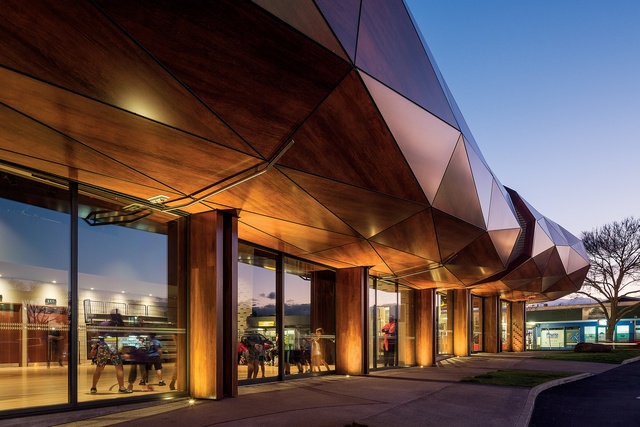
Conceptually, the design is a grove of trees, an idea arising from a local legend and place name and this is apparent in a couple of ways. Each external column includes a carving that represents the tree of a particular culture and, inside the building, there is a homogeneity of layout rather than a hierarchy. The staff members tell me the place “goes nuts after school” and the layout is a cluster of studios, booths, workrooms and meeting spaces, including a large, double-height theatre space: a collection of spaces manned by technicians into which school kids and other mātātahi can disappear – a grand tree hut.
Because I’m an academic and we live in ivory towers, I was wondering how Te Oro could possibly be clad in ply. It’s not, of course; the triangular facets are Alucobond with a timber look. Architect Lindsay Mackie, like anyone of our generation who was reared towards the end of modernism, is a bit conflicted about the cladding’s honesty but we do have a fancy term for this sort of thing; the building’s skin is skeuomorphic.
A skeuomorph is a new thing that retains a semblance of the old. At one end of the spectrum, it is fake wood or plastic chairs pretending they are carved from wood but, most famously in Apple products, skeuomorphism makes new things seem to have some of the qualities of the old that afford us comfort or, in the case of Apple interfaces, enhanced usability: the shutter click sound on a digital camera, for instance, or a folder on a computer screen that looks like an old cardboard one.
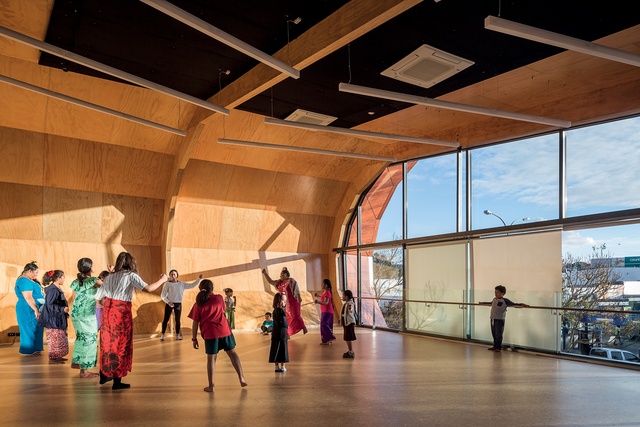
Te Oro also has a good dose of cross-cultural hybridity. The carvings around its base were crafted mostly by Māori but cut on a CNC router – this doesn’t make them any less honest or authentic. And the sound stations located around the perimeter, that speak or sing as you pass, are the mix of tradition and modern technology to which both Māori and Pacific Islanders have been open since first contact with Western cultures.
Te Oro is a long-awaited and welcome addition to the heart of Glen Innes, which is also expressive of the mix of cultures at this end of the Pacific Ocean. This multi-purpose building is a vessel that will nurture young dreams, host the teaching of skills and enable success. It’s also part of the new wave of wonderful Auckland public buildings that is marking the city’s step forward into a more cosmopolitan century that expresses our place and our people in the world.

